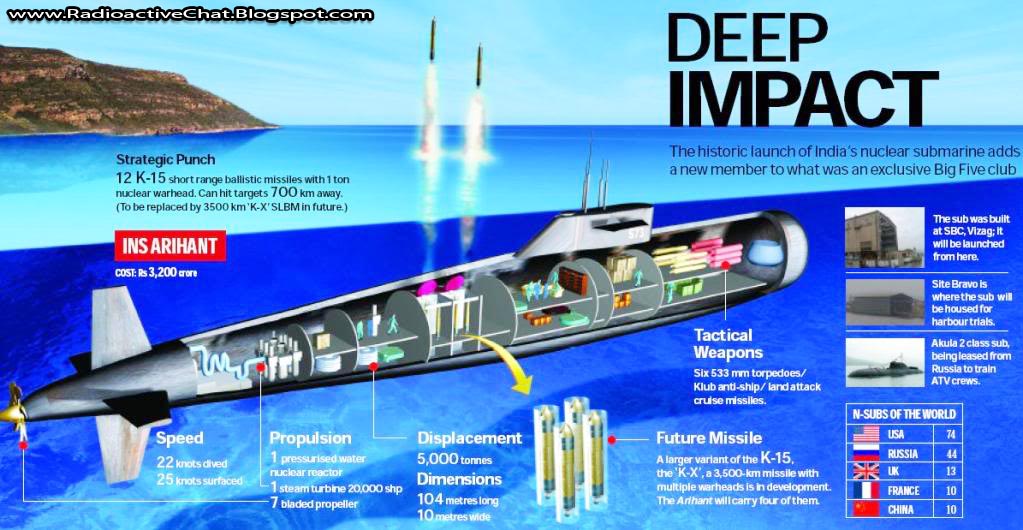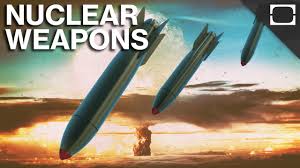This paper looks at SSBNs (Ship Submersible, ballistic, nuclear) with India in mind. India planned to build nuclear-enabled propulsion in the 1970s and launched its SSBN; INS Arihant on July 26, 2009 (Kumar, 2009). Before this India has operated two SSNs both named INS Chakra, on lease from USSR (Jiampietro, 1988) and Russia respectively. The second of which is currently in service. India also has two more SSBNs at different stages of development (Davenport, 2015).

What are SSBNs?
While many have claimed this development to be in response to China’s capability in this domain, the Indian SSBN has become a reason for Pakistan to seek similar platforms (Singh, 2012).
SSBNs are strategic platforms. States like India would not want to depend on a security umbrella for their strategic needs because often the dependence has its limitations and costs. Also, a threat can never be properly understood till it manifests in one form and then also there is no guarantee that it will manifest in the same form again. While attempting to address security concerns, SSBNs enlarge the perception of retribution to others. It is a promise that there will be a reply in kind if red lines are crossed.
By securitization theory, the referent object, in this case, is a state, but during a war, the referent object can change based on the perception of the leadership (Peoples & Vaughan-Williams, 2015). If there is significant damage to the national security architecture that disables the conventional defensive capabilities, a state may be compelled to take actions that it might have reserved for a nuclear attack on its territory. Nuclear weapons are a product of securitisation against an enemy that has nuclear weapons or a latent capacity to develop them.
India is the newest entrant to the club of SSBN operators but its weapon systems, primarily the SLBMs; K-15 and K-4 have not been fully operationalized (Gady, 2016).The Nirbhay and submarine-launched Brahmos cruise missiles are under development (Davenport, 2015). Within the region, India is fairly status quo-ist (Ahmed, 2014) but in the wider world, it is revisionist (Paranjpe, 2013), in that it seeks a place at the UN Security Council and seeks exceptions from the world order to make India a more mainstream power. India has been moving away from the bracket of NAM and other Afro-Asian countries (Paranjpe, 2013). The possession of SSBNs doesn’t make it a global power; it does expand the region of influence.
Focus on Delivery Platforms
In a world where most advanced possessors of atomic bombs are not testing the bombs anymore, the scope for improvement of bomb design and effectiveness is theoretical and untested (Clarke, 2004) but this has led to greater focus on improvement of delivery platforms. SSBNs derive their primacy from the ultimately destructive nature of thermonuclear warheads that they carry (Clarke, 2004).
SSBNs derive their primacy from the ultimately destructive nature of thermonuclear warheads that they carry
During the cold war, security studies were preoccupied with the four Ss, namely, states, strategy, science and status quo (Williams, 2008). The SSBN, popularly called ballistic missile submarine or a boomer reflects this thinking very well. It defends the state, is always a strategic asset(in most countries the submarines are operated by the Navy, but the strategic forces always have a hand. Ex. India, China, USA, Russia) (Russian Strategic Nuclear Forces Under New START | Arms Control Association, 2017). When the first nuclear submarine the USS Nautilus was completed in 1955, it weighed around 2800 tons, cost $40,000,000. (Nautilus Goes to Sea to Test Equipment, 1955) (Submarine Force Museum Home of Historic Ship Nautilus, 2017) and produced enough energy for a city of 20000. (New Machines and Gadgets, 1956). The Indian Arihant is 6000 tons, and its birth has taken place at a time when China is increasingly becoming more assertive and is expanding its maritime assets to the Indian Ocean, the way Soviet navy was asserting itself in the 1960s.
The Power of Submarines
SSBNs have often led to the greater accumulation of submarines by competitive powers. The USS Nautilus was a technological marvel, and it distorted the existing status quo compelling the USSR to come up with its first nuclear-powered submarine. None of them were SSBNs. They were torpedo attack submarines. The first SSBN was the USS George Washington commissioned in 1959 which was followed by the K-19 of USSR. With both powers building up their SSBN fleets a form of dynamic equilibrium came into being with the USA always having an edge regarding number of submarines deployed and range of SLBMs on board (Blair, Feiveson, & Hippel, 1997)
Often, to reemphasize security and inform your opponent of your capabilities, there is an effort of the overt display by organizing exercises or publicly announcing successful missile or weapons commissioning. But in the case of SSBNs, it is about staying hidden with the capacity to hit at the deepest cores of the enemy for it carries SLBMs (submarine-launched ballistic missiles). India did not even officially declare the commissioning of Arihant. Though every future or tentative opponent has an idea of the ships and submarines of its enemy, what’s unclear is the capability and capacity of the opponent. The critical issue is not just the submarines theoretical capability but also the crew’s ability to use the submarine to its highest potential. This requires ample training and capacity development through regular exercises and deployments. The aim is to fit into the doctrine of the state and attaining the laid down objectives. While during cold war there was an accumulation spree. SSBN effectiveness is increased by greater stealth. They, however, can be supplemented by larger number of SSNs and SSKs (diesel-electric hunter-killer submarines)
SLBMs, considered safer from a first strike than land-based ICBM, are a backup deterrent (Kristensen & FAS, China’s Nuclear Missile Submarine Base, 2006). They guarantee a second strike and the destruction of human life at a magnitude that has not happened in the recorded history and hence prevent the first strike by an opponent. A situation is created where the possessor is seen as a threat by those well beyond the borders as a nuclear submarine is only constrained in range and endurance by the amount of supplies (food) it can carry. SSBNs can create their oxygen, and all personnel on board carry an emergency supply with themselves. SLBMs allow a willingness to absorb the first strike and then hit back. This stems from a realization that the enemy can successfully deploy and detonate a nuclear warhead on the territory of the said state. SLBMs are retaliatory weapons. This happens to be the rationale behind India’s quest for SSBNs. These platforms provide a flexibility of reaching any point on earth. The farthest place on land from the seas is Lat. 46º16.8’N, Long. 86º40.2’E in Dzungarian Basin in China at 2,648 km (Land farthest from sea, 2017). So with a 3000 km, SLBM like the K-4, any place on earth can be targeted. They are less likely to be pre-empted or tracked than ship-based, flight based or land based ICBMs. (Kumar, 2009)
Having an SSBN is not a promise of credible sea-based deterrence.
Having an SSBN is not a promise of credible sea-based deterrence. The enemy may well know the positions of submarines if it has been quietly trailing the few SSBNs that a country might possess. This is especially the case when the adversary is advanced in quantitative and more essentially technologically qualitative ways.
Possessions of SSBNs can always be construed as a threat, but their non-possessing can also lead to a situation of absence of deterrence, for other platforms can be more easily compromised. A state can tilt the balance so against itself in a total war situation that it will have to surrender as was in the case of Japan in World War II.
Jyoti Ranjan Pradhan
Jyoti Ranjan Pradhan








